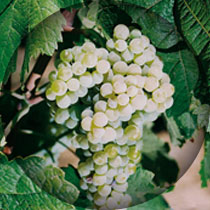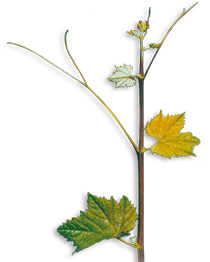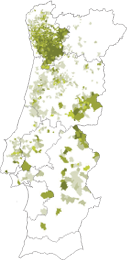Arinto (PT)
Variety: white | Category I | Portugal


General Information
Arinto


Origin: In 1721, Alarte referred to the excellent quality of this variety. Brotero (1788) noted its small berries and high acid content. Silva and Telles (1790) knew of the existence of this variety in the Beiras, the Douro and Estremadura, as did Lacerda Lobo (1790) in Minho under the synonym Pedernã. By contrast, Lapa (1866/7) refers to Évora, Arruda, Torres Vedras, Colares and Carcavelos. Menezes (1896) mentioned Bucelas and Portalegre.
Chief areas of distribution: All over Portugal.
Official synonym(s) (national and OIV): Pederná.
Historic and regional synonyms: Pedernão (Douro), Arinto de Bucelas, Arintho, Val de Arintho; Pedreña (ES). Vila Maior and his French colleague, Puillat, speculated that Arinto wine bore some similarity with the German Riesling, although Carvalho (1912) dispelled this error of judgement.
Homonym(s): : Arinto do Interior, Arinto Roxo, and Arinto Azores (incorrect regional name, which actually refers to the Terrantez da Terceira).
Area under cultivation: 5,900 ha.
Trend: Slight upward.
Varietal variability: Medium to high.
Availability of propagating material: RNSV polyclonal material, certified clones 36 - 40 RNSV; 34, 35, 107 JBP.
Molecular Profile (OIV)
Regional Classification
Morphology
Phenology
Vegetative Potential
Viticultural Parameters
Oenology
Variety Characteristics
| VVMD5 | VVMD7 | VVMD27 | VrZag62 | VrZag79 | VVS2 | ||||||
| Allele1 | Allele2 | Allele1 | Allele2 | Allele1 | Allele2 | Allele1 | Allele2 | Allele1 | Allele2 | Allele1 | Allele2 |
| 226 | 238 | 239 | 247 | 181 | 185 | 186 | 188 | 247 | 251 | 145 | 153 |
Young shoot (form of tip): Open, with crimson red tip, very dense hairs.
Young leaf: Green with copper spots, very dense erect hairs on ventral side.
Young shoot: Red stripes on the dorsal side of nodes and internodes, green buds.
Inflorescence (sex of flower): Hermaphrodite.
Mature leaf: Large, pentagonal, three lobes. Upper side of blade green, regular, medium blistering of upper side of blade, rugose, lower side of blade velvety, with erect hairs of medium density. Short convex teeth, closed V-shaped petiolar sinus.
Bunch: Large, conical, multiple wings, dense. Medium to large peduncle.
Berry: Short, elliptic, greenish blue. Medium expression of berry skin, soft flesh.
Woody shoot: Dark brown.
Time of bud burst: Late, 9 days after the Fernão Pires.
Flowering: Normal, 5 days after the Fernão Pires.
Berry (colour change): Late, 16 days after the Fernão Pires.
Berry (harvest ripe): Late, two weeks after the Fernão Pires.
Vigour of shoot growth: High.
Pruning weight:: In warmer zones, 1,800 – 3,000 kg/ha, depending on clone and environment.
Shoot attitude (habit): Upright, heliotropic. Some terminal shoots may develop a strong lateral habit and become very long.
Length of internodes: Varies. Some medium to long, others long.
Shoot length: Medium to large, some semi-erect and very long, sometimes with shoot tips not fully formed.
Tendency to form lateral shoots: Medium, particularly in the case of longer shoots.
Rate of multiple bud bursts: Some medium to long, others short.
Bud fertility index: Low: on average, 0.8 flowers per shoot. Maximum one bunch per shoot.
Yield: Low yield with traditional material. Certified clones achieve high yields (10 - 15 t/ha). RNSV statistical value: 1.39 kg/vine (Average of at least 40 clones in Sesimbra over 5 years).
Yield consistency: Regular, but in vineyards employing incorrect conduction systems, production of canes can compromise yield.
Crop uniformity: Homogenous behaviour with clonal material.
Winkler Index: 1,229 (average); 1,384 for a 14 t/ha yield (Montemor).
: 10% GLRaV-1; 65% GLRaV-3; 5% GLRaV-2 and -6; 75% GFkV; 5% RRV; <50% RSPV.
Sensitivity to abiotic factors: Sensitive to wind before flowering, and to soils with poor water retention.
Susceptibility to fungal diseases: Susceptible to Peronospora, Oidium, Excoriosis (Phomopsis viticola Sacc.), and Bunch Rot. Has some resistance to Anthracnose.
Susceptibility to Pests: Susceptible to the vine leafhopper and the grape berry moth.
Bunch size: Large (350 - 450 g) in warm zones; in maritime regions, 613 - 675 g.
Bunch density: Dense to very dense; sometimes bunches come apart on their own.
Berry size: Small (0.8 – 1.5 g), varies according to clone and the environment. Varies according to the clone and the environment.
Berry skin: Medium.
Seeds per berry: 1.7-2.4.
Vineyard conduction system: Yield increases with arched cane training systems, although the Cordon Royal is common. It is difficult to achieve the correct balance between quality and quantity. This variety has large leaves; pruning is therefore recommended to prevent the foliage from becoming too dense.
Soil requirement: Acid or calcareous soils, deep and moist, but well-drained, and not too dense, with orientation towards the North.
Climatic requirements: Zones inland, or coastal regions with moderate climates.
Vine density: Vine should be spaced 1 m apart, in rows at intervals of 2.5 m.
Rootstock: Compatible with almost all rootstock. It is important to achieve a balance between vegetation and fruit. Rootstock with lower vigour is therefore recommended (420 A, 3309 C, 196-17, SO4).
Irrigation: Sensitive to drought stress. Irrigation therefore recommended in dry and poor soils.
Incidence of coulure/millerandage: Low in respect of coulure, although at medium risk in respect of millerandage.
Spoilage of mature berries: Some blue mould rot, but very little drought damage on the bunch.
Risk of bird damage: Very low.
Machine harvest suitability: Well suited in moderate temperatures only.
Wine type: DOC quality wine and regional wine.
Potential alcohol content: Average in coastal regions: 11% vol. Inland average is 13% vol. (RNSV statistical value: 11.53% vol. Average of at least 40 clones in Southern Portgual over a one-year period).
Natural acidity of must: Quite high (total acid, 6 - 9 g/l; malic acid, 1.9 g/l; tartaric acid, 7 g/l). (RNSV statistical value: 7.88 g/l. Average of at least 40 clones in Mealhada over a one-year period).
Risk of oxidation of must: Low.
Colour intensity of wine: Lemon yellow; with late harvest, the colouration can become very intense.
Tannins: Monomeric 1.3 – 1.7 mg/l; Oligomeric 1.1 – 3.7 mg/l; Polymeric 4.3 – 10.9 mg/l.
Total polyphenol index (at 280 nm): 93 - 119 mg/l.
Risk of oxidation of wine: Low.
Aromatic profile: Citrus fruits. Terpenoid compounds (Alentejo, 1997 and 1998), 415 μg/l (1997), 497 μg/l (1998); total benzenoids 472 μg/l (1997), 527 μg/l (1998); total norisoprenoids, 259 μg/l (1997), 361 μg/l (1998).
Ageing Potential: High; the wine improves with ageing. Suitable for storage in barrels.
Blending recommendation: Antão Vaz, Gouveio, Malvasia Fina, Fernão Pires, Trincadeira das Pratas, Vital, Síria. It is generally suitable for blending with wines of a low acid content.
Wine Descriptors: Clear lemon yellow, sometime with mineral notes of medium intensity. Over the course of ageing, it develops an aroma reminiscent of honey, but also a little of kerosene. One tastes the acid in the mouth, but in a wonderful interplay with fruity tones. (P. Laureano).
Wine quality: Very high, given the right vineyard conditions. Pilot grapevine variety, even though it is somewhat difficult to cultivate. The Arinto poses a challengue for oenologists, too.
Variety Characteristics: unavailable

